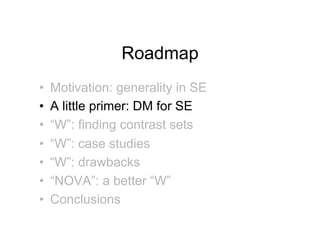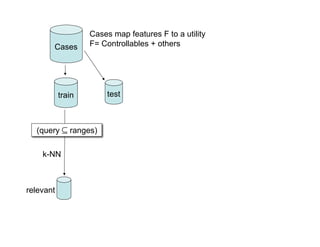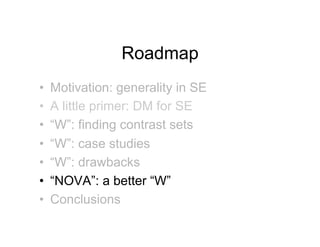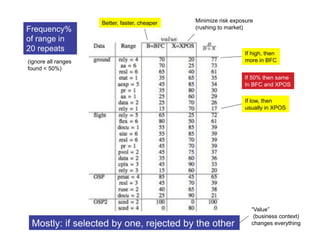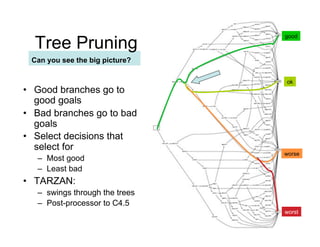Finding local lessons in software engineering
- 1. Finding local lessons in software engineering Tim Menzies, WVU, USA, [email protected] Tsinghua University, China, Nov’09
- 2. Sound bites •! An observation: –! Surprisingly few general SE results. •! A requirement: –! Need simple methods for finding local lessons. •! Take home lesson: –! Finding useful local lessons is remarkably simple –! E.g. using “W” or “NOVA”
- 3. Roadmap •! Motivation: generality in SE •! A little primer: DM for SE •! “W”: finding contrast sets •! “W”: case studies •! “W”: drawbacks •! “NOVA”: a better “W” •! Conclusions
- 4. Roadmap •! Motivation: generality in SE •! A little primer: DM for SE •! “W”: finding contrast sets •! “W”: case studies •! “W”: drawbacks •! “NOVA”: a better “W” •! Conclusions
- 5. 5/4 4
- 6. Have we lived up to our PROMISE? Few general results •! PROMISE 2005 … 2009 : 64 presentations •! 48 papers –! tried a new analysis on old data –! Or reported a new method that worked once for one project. •! 4 papers –! argued against model generality •! 9 papers –! questioned validity of prior results •! E.g. Menzies et al. Promise 2006 –! 100 times •! Select 90% of the training data •! Find<a,b> in effort = x.a.LOC b
- 7. Have we lived up to our PROMISE? Only 11% of papers proposed general models •! E.g. Ostrand, Weyuker, Bell ‘08, ‘09 –! Same functional form –! Predicts defects for generations of AT&T software •! E.g. Turhan, Menzies, Bener ’08, ‘09 –! 10 projects •! Learn on 9 •! Apply to the 10th –! Defect models learned from NASA projects work for Turkish whitegoods software •! Caveat: need to filter irrelevant training examples
- 8. Less Promising Results Lessons learned are very localized •! FSE’09: Zimmerman et al. –! Defect models not generalizable •! Learn “there”, apply “here” only works in 4% of their 600+ experiments –! Opposite to Turhan’09 results •! ?add relevancy filter •! ASE’09: Green, Menzies et al. –! AI search for better software project options –! Conclusions highly dependent on local business value proposition •! And others –! TSE’06: Menzies, Greenwald –! Menzies et al. in ISSE 2007 –! Zannier et al ICSE’06
- 9. Overall The gods are (a little) angry •! Fenton at PROMISE’ 07 –! "... much of the current software metrics research is inherently irrelevant to the industrial mix ...” –! "... any software metrics program that depends on some extensive metrics collection is doomed to failure ...” •! Budgen & Kitchenham: –! “Is Evidence Based Software Engineering mature enough for Practice & Policy? ” –! Need for better reporting: more reviews. –! Empirical SE results too immature for making policy. •! Basili : still far to go –! But we should celebrate the progress made over the last 30 years. –! And we are turning the corner
- 10. Experience Factories Methods to find local lessons •! Basili’09 (pers. comm.): –! “All my papers have the same form. –! “For the project being studied, we find that changing X improved Y.” •! Translation (mine): –! Even if we can’t find general models (which seem to be quite rare)…. –! … we can still research general methods for finding local lessons learned
- 11. The rest of this talk: contrast set learning and “W” W= a local lessons finder •! Bayesian case-based accuracy contrast-set learner –! uses greedy search –! illustrates the “local lessons” effect –! offers functionality missing in the effort-estimation literature •! Fast generator of baseline results –! There are too few baseline results –! And baseline results can be very interesting (humbling). Holte’85 • C4: builds decision trees “N” deep •! A very (very) simple algorithm • 1R: builds decision trees “1” deep • For datasets with 2 classes, 1R ! C4 –! Should add it to your toolkit –! At least, as the “one to beat”
- 12. Roadmap •! Motivation: generality in SE •! A little primer: DM for SE •! “W”: finding contrast sets •! “W”: case studies •! “W”: drawbacks •! “NOVA”: a better “W” •! Conclusions
- 14. 14/ 46 good Tree Pruning Can you see the big picture? ok •! Good branches go to good goals •! Bad branches go to bad goals •! Select decisions that select for worse –! Most good –! Least bad •! TARZAN: –! swings through the trees –! Post-processor to C4.5 worst
- 15. 15/ 46 good Tree Pruning Can you see the big picture? ok •! Good branches go to good goals •! Bad branches go to bad goals •! Select decisions that select for worse –! Most good –! Least bad •! TARZAN: –! swings through the trees –! Post-processor to C4.5 worst
- 16. 16/ 46 good Tree Pruning Can you see the big picture? ok •! Good branches go to good goals •! Bad branches go to bad goals •! Select decisions that select for worse –! Most good –! Least bad •! TARZAN: –! swings through the trees –! Post-processor to C4.5 worst
- 17. 17/ 46 good Comment Less is best ok •! Higher decisions prune more branches •! #nodes at level I much smaller than level I+1. •! So tree pruning often yields very small sets of worse recommendations worst
- 18. Don’t bury me in data Don’t show me “what is”; just tell what “to do”
- 19. Roadmap •! Motivation: generality in SE •! A little primer: DM for SE •! “W”: finding contrast sets •! “W”: case studies •! “W”: drawbacks •! “NOVA”: a better “W” •! Conclusions
- 20. “W”= Simple (Bayesian) Contrast Set Learning (in linear time) Mozina: KDD’04 •! “best” = target class (e.g. “survive”) •! “rest” = other classes •! x = any range (e.g. “sex=female”) •! f(x|c) = frequency of x in class c •! b = f( x | best ) / F(best) •! r = f( x | rest ) / F(rest) •! LOR= log(odds ratio) = log(b/r) –! ? normalize 0 to max = 1 to 100 •! s = sum of LORs –! e = 2.7183 … –! p = F(B) / (F(B) + F(R)) –! P(B) = 1 / (1 + e^(-1*ln(p/(1 - p)) - s ))
- 21. “W”:Simpler (Bayesian) Contrast Set Learning (in linear time) Mozina: KDD’04 •! “best” = target class •! “rest” = other classes •! x = any range (e.g. sex = female) •! f(x|c) = frequency of x in class c •! b = f( x | best ) / F(best) •! r = f( x | rest ) / F(rest) •! LOR= log(odds ratio) = log(b/r) –! ? normalize 0 to max = 1 to 100 •! s = sum of LORs –! e = 2.7183 … “W”: 1)! Discretize data and outcomes –! p = F(B) / (F(B) + F(R)) 2)! Count frequencies of ranges in classes –! P(B) = 1 / (1 + e^(-1*ln(p/(1 - p)) - s )) 3)! Sort ranges by LOR 4) Greedy search on top ranked ranges
- 22. “W” + CBR Preliminaries •! “Query” –! What kind of project you want to analyze; e.g. •! Analysts not so clever, •! High reliability system •! Small KLOC •! “Cases” –! Historical records, with their development effort •! Output: –! A recommendation on how to change our projects in order to reduce development effort
- 23. Cases map features F to a utility Cases F= Controllables + others train test
- 24. Cases map features F to a utility Cases F= Controllables + others train test (query ! ranges) k-NN relevant
- 25. Cases map features F to a utility Cases F= Controllables + others train test (query ! ranges) k-NN Best utilities x b = F(x | best) / F(best) relevant x r = F(x | rest) / F(rest) rest
- 26. Cases map features F to a utility Cases F= Controllables + others train test (query ! ranges) S = all x sorted descending by score k-NN Best utilities x b = F(x | best) / F(best) if controllable(x) && b > r && relevant b > min x r = F(x | rest) / F(rest) then score(x) = log(b/r) else score(x) = 0 rest fi
- 27. Cases map features F to a utility Cases F= Controllables + others queryi* = k-NN train test query + "iSi treatedi (query ! ranges) S = all x sorted descending by score k-NN Best utilities x b = F(x | best) / F(best) if controllable(x) && b > r && relevant b > min x r = F(x | rest) / F(rest) then score(x) = log(b/r) else score(x) = 0 rest fi
- 28. Cases map features F to a utility Cases F= Controllables + others utility median queryi* = k-NN spread train test i query + "iSi treatedi (query ! ranges) S = all x sorted descending by score k-NN Best utilities x b = F(x | best) / F(best) if controllable(x) && b > r && relevant b > min x r = F(x | rest) / F(rest) then score(x) = log(b/r) else score(x) = 0 rest fi
- 29. Cases map features F to a utility treatment Cases F= Controllables + others q 0* q i* utility median queryi* = k-NN spread train test i query + "iSi treatedi As is To be (query ! ranges) S = all x sorted descending by score k-NN Best utilities x b = F(x | best) / F(best) if controllable(x) && b > r && relevant b > min x r = F(x | rest) / F(rest) then score(x) = log(b/r) else score(x) = 0 rest fi
- 30. Roadmap •! Motivation: generality in SE •! A little primer: DM for SE •! “W”: finding contrast sets •! “W”: case studies •! “W”: drawbacks •! “NOVA”: a better “W” •! Conclusions
- 31. Results (distribution of development efforts in qi*) Using cases from http://promisedata.org Cases from promisedata.org/data Median = 50% percentile Spread = 75% - 25% percentile Improvement = (X - Y) / X •! X = as is •! Y = to be •! more is better 150% Usually: •! spread " 75% improvement spread improvement 100% •! median " 60% improvement 50% 0% -50% 0% 50% 100% 150% median improvement
- 32. Not-so-good news Local lessons are very localized
- 33. Roadmap •! Motivation: generality in SE •! A little primer: DM for SE •! “W”: finding contrast sets •! “W”: case studies •! “W”: drawbacks •! “NOVA”: a better “W” •! Conclusions
- 34. Cases map features F to a utility treatment Cases F= Controllables + others q 0* q i* utility median queryi* = k-NN spread train test i query + "iSi treatedi As is To be (query ! ranges) S = all x sorted descending by score k-NN Best utilities x b = F(x | best) / F(best) if controllable(x) && b > r && relevant b > min x r = F(x | rest) / F(rest) then score(x) = log(b/r) else score(x) = 0 rest fi
- 35. Cases map features F to a utility treatment Cases F= Controllables + others q 0* q i* utility median queryi* = k-NN spread train test i query + "iSi treatedi As is To be (query ! ranges) S = all x sorted descending by score k-NN Best utilities x b = F(x | best) / F(best) if controllable(x) && b > r && relevant b > min x r = F(x | rest) / F(rest) then score(x) = log(b/r) else score(x) = 0 rest fi
- 36. Cases map features F to a utility treatment Cases F= Controllables + others A greedy linear time search? q 0* q i* utility • Need to use much better search algorithms median • Simulated annealing, Beam, *Astar, ISSAMP, MaxWalkSat queryi = k-NN spread • SEESAW test train (home brew) i query + "iSi treatedi As is To be (query ! ranges) S = all x sorted descending by score k-NN Best utilities x b = F(x | best) / F(best) if controllable(x) && b > r && relevant b > min x r = F(x | rest) / F(rest) then score(x) = log(b/r) else score(x) = 0 rest fi
- 37. Cases map features F to a utility treatment Cases F= Controllables + others q 0* q i* utility median queryi* = k-NN spread train test i query + "iSi treatedi As is To be (query ! ranges) S = all x sorted descending by score k-NN Best utilities x b = F(x | best) / F(best) if controllable(x) && b > r && relevant b > min x r = F(x | rest) / F(rest) then score(x) = log(b/r) else score(x) = 0 rest fi
- 38. Cases map features F to a utility treatment Cases F= Controllables + others q 0* q i* utility median queryi* = k-NN spread train test i query + "iSi treatedi As is To be (query ! ranges) S = all x sorted descending by score k-NN Best utilities x b = F(x | best) / F(best) if controllable(x) && b > r && relevant b > min x r = F(x | rest) / F(rest) then score(x) = log(b/r) else score(x) = 0 rest fi
- 39. Cases map features F to a utility treatment Cases F= Controllables + others q 0* q i* utility Just trying to reduce effort? median queryi* = k-NN spread • train test What aboutquery + " S development time? i i i • What about number of defects? i treated As is To be • What about different business contexts? (query ! ranges) “racing to = all x sorted descending by score e.g. S market” vs “mission-critical” apps k-NN Best utilities x b = F(x | best) / F(best) if controllable(x) && b > r && relevant b > min x r = F(x | rest) / F(rest) then score(x) = log(b/r) else score(x) = 0 rest fi
- 40. Cases map features F to a utility treatment Cases F= Controllables + others q 0* q i* utility median queryi* = k-NN spread train test i query + "iSi treatedi As is To be (query ! ranges) S = all x sorted descending by score k-NN Best utilities x b = F(x | best) / F(best) if controllable(x) && b > r && relevant b > min x r = F(x | rest) / F(rest) then score(x) = log(b/r) else score(x) = 0 rest fi
- 41. Cases map features F to a utility treatment Cases F= Controllables + others q 0* q i* utility median queryi* = k-NN spread train test i query + "iSi treatedi As is To be (query ! ranges) S = all x sorted descending by score k-NN Best utilities x b = F(x | best) / F(best) if controllable(x) && b > r && relevant b > min x r = F(x | rest) / F(rest) then score(x) = log(b/r) else score(x) = 0 rest fi
- 42. Cases map features F to a utility treatment Cases F= Controllables + others q 0* q i* utility median queryi* = k-NN spread train test i query + "iSi treatedi As is To be (query ! ranges) Is nearestall x sorted descending by score S = neighbor causing conclusion instability? k-NN Best utilities • Q: How to smooth the bumps between x between the samples ? b = F(x | best) / F(best) if controllable(x) && b > r && relevant • A: Don’t apply constraints to the data b > min x r = F(x | • Apply it as model inputs instead rest) / F(rest) then score(x) = log(b/r) else score(x) = 0 rest fi
- 43. Cases map features F to a utility treatment Cases F= Controllables + others q 0* q i* utility median queryi* = k-NN spread train test i query + "iSi treatedi As is To be (query ! ranges) S = all x sorted descending by score k-NN Best utilities x b = F(x | best) / F(best) if controllable(x) && b > r && relevant b > min x r = F(x | rest) / F(rest) then score(x) = log(b/r) else score(x) = 0 rest fi
- 44. Cases map features F to a utility treatment Cases F= Controllables + others q 0* q i* utility median queryi* = k-NN spread train test i query + "iSi treatedi As is To be (query ! ranges) S = all x sorted descending by score k-NN Best utilities x b = F(x | best) / F(best) if controllable(x) && b > r && relevant b > min x r = F(x | rest) / F(rest) then score(x) = log(b/r) else score(x) = 0 rest fi
- 45. Cases map features F to a utility treatment Cases F= Controllables + others q 0* q i* utility median queryi* = k-NN spread train test i query + "iSi treatedi As is To be (query ! ranges) Justall x sorted descending by score S = one test? k-NN Best • What about looking for utilities stability in “N” repeats? x b = F(x | best) / F(best) if controllable(x) && b > r && relevant b > min x r = F(x | rest) / F(rest) then score(x) = log(b/r) else score(x) = 0 rest fi
- 46. Cases map features F to a utility treatment Cases F= Controllables + others q 0* q i* 1 More tests utility median queryi* = k-NN spread train test i query + "iSi treatedi As is To be (query ! ranges) S = all x sorted descending by score k-NN Best utilities x b = F(x | best) / F(best) if controllable(x) && b > r && relevant b > min x r = F(x | rest) / F(rest) then score(x) = log(b/r) else score(x) = 0 rest fi
- 47. Cases map features F to a utility treatment Cases F= Controllables + others q 0* q i* 1 More tests utility median queryi* = k-NN spread train test i query + "iSi treatedi As is To be (query ! ranges) S = all x sorted descending by score k-NN 2 Best utilities More models x b = F(x | best) / F(best) if controllable(x) && b > r && relevant b > min x r = F(x | rest) / F(rest) then score(x) = log(b/r) else score(x) = 0 rest fi
- 48. Cases map features F to a utility 3 More goals treatment Cases F= Controllables + others q 0* q i* 1 More tests utility median queryi* = k-NN spread train test i query + "iSi treatedi As is To be (query ! ranges) S = all x sorted descending by score k-NN 2 Best utilities More models x b = F(x | best) / F(best) if controllable(x) && b > r && relevant b > min x r = F(x | rest) / F(rest) then score(x) = log(b/r) else score(x) = 0 rest fi
- 49. Cases map features F to a utility 3 More goals treatment Cases F= Controllables + others q 0* q i* 1 More tests utility median queryi* = k-NN spread train test i query + "iSi treatedi As is To be (query ! ranges) S = all x sorted descending by score k-NN 2 Best 4 More search utilities More models x b = F(x | best) / F(best) if controllable(x) && b > r && relevant b > min x r = F(x | rest) / F(rest) then score(x) = log(b/r) else score(x) = 0 rest fi
- 50. Roadmap •! Motivation: generality in SE •! A little primer: DM for SE •! “W”: finding contrast sets •! “W”: case studies •! “W”: drawbacks •! “NOVA”: a better “W” •! Conclusions
- 51. More models USC Cocomo suite (Boehm 1981, 2000)! COCOMO •! Time to build it (calendar months) •! Effort to build it (total staff months) COQUALMO •! defects per 1000 lines of code Estimate = model( p, t ) •! P = project options •! T = tuning options •! Normal practice: Adjust “t” using local data •! NOVA: Stagger randomly all tunings even seen before ?
- 52. More goals B = BFC X = XPOS Goal #1: Goal #2 •! better, faster, cheaper •! minimize risk exposure Try to minimize: Rushing to beat the competition •! Development time and •! Get to market, soon as you can •! Development effort and •! Without too many defects •! # defects
- 53. More search engines Not greedy search! Simulated Annealling ISSAMP ASTAR BEAM MaxWalkSat SEESAW : MaxWalkSat + boundary mutation •! Local favorite •! Does best at reduction defects or effort or time
- 54. More tests Four data sets, repeat N=20 times! Data sets •! OSP= orbital space plane GNC •! OSP2 = second generation GNC •! Flight = JPL flight systems •! Ground = JPL ground systems For each data set •! Search N= 20 times (with SEESAW) •! Record how often decisions are found
- 55. Better, faster, cheaper Minimize risk exposure Frequency% (rushing to market) of range in 20 repeats If high, then (ignore all ranges more in BFC found < 50%) If 50% then same In BFC and XPOS If low, then usually in XPOS “Value” (business context) Mostly: if selected by one, rejected by the other changes everything
- 56. Better, faster, cheaper Minimize risk exposure And what of (rushing to market) defect removal techniques? Aa = automated analysis Etat= execution testing and tools Pr= peer review Stopping defect introduction is better than defect removal.
- 57. Roadmap •! Motivation: generality in SE •! A little primer: DM for SE •! “W”: finding contrast sets •! “W”: case studies •! “W”: drawbacks •! “NOVA”: a better “W” •! Conclusions
- 58. Certainly, we should always strive for generality But don’t be alarmed if you can’t find it •! The experience to date is that, –! with rare exceptions, –! W and NOVA do not lead to general theories •! But that’s ok –! Very few others have found general models (in SE) –! E.g. Turhan, Menzies, Ayse’09 •! Anyway –! If there are few general results, there may be general methods to find local results
- 59. Btw, constantly (re)building local models is a general model Case-based reasoning •! Kolodner’s theory of reconstructive memory •! The Yale group –! Shank & Riesbeck et al. –! Memory, not models –! Don’t “think”, remember
- 60. See you at PROMISE’10? http://promisedata.org/2010
- 62. Contact details We know where you live. •! [email protected] •! http://menzies.us •! http://twitter.com/timmenzies •! http://www.facebook.com/tim.menzies
- 63. 63/ 46 Questions? Comments? “You want proof? I’ll give you proof!”
- 64. 64/ 46 Future work What’s next? •! Better than Bgreedy? –! While staying simple? •! Incremental anomaly detection and lesson revision –! Not discussed here –! Turns out, that may be very simple (see me later)
- 65. 65/ 46 A little primer: DM for SE Summary: easier than you think (#include standardCaveat.h)
- 66. 66/ 46 Monte Carlo + Decision Tree Learning Menzies: ASE’00 •! Process models –! Input: project details –! Output: (effort, risk) •! Increase #simulations –! till error minimizes •! Learn decision trees •! Repeat 10 times
- 67. 67/ 46 Software Management Given nowi which subsets of changesi is most effective?
- 68. 68/ Problem 46 Too much information
- 69. 69/ 46 good Tree Pruning Can you see the big picture? ok •! Good branches go to good goals •! Bad branches go to bad goals •! Select decisions that select for worse –! Most good –! Least bad •! TARZAN: –! swings through the trees –! Post-processor to C4.5 worst
- 70. 70/ 46 good Tree Pruning Can you see the big picture? ok •! Good branches go to good goals •! Bad branches go to bad goals •! Select decisions that select for worse –! Most good –! Least bad •! TARZAN: –! swings through the trees –! Post-processor to C4.5 worst
- 71. 71/ 46 good Tree Pruning Can you see the big picture? ok •! Good branches go to good goals •! Bad branches go to bad goals •! Select decisions that select for worse –! Most good –! Least bad •! TARZAN: –! swings through the trees –! Post-processor to C4.5 worst
- 72. 72/ 46 good Comment Less is best ok •! Higher decisions prune more branches •! #nodes at level I much smaller than level I+1. •! So tree pruning often yields very small sets of worse recommendations worst
- 73. 73/ 46 Don’t bury me in data Don’t show me “what is”; just tell what “to do”
- 74. Given the size of the search space, 74/ 46 the small number of decision points was very surprising
- 75. 75/ The “keys” effect: 46 usually, a few variables set the rest SAILing is easy •! So the complexity of the whole depends on just a small part •! Empirical evidence: –! Feature subset selection: Kohavi’97 –! Few pathways: Bieman’92, Harrold’98 –! Mutation testing & rapid saturation: Budd’80, Wong’95, Michael’97 –! Surprisingly few internal states: Drezdel’94, Colomb’00, Menzies’99 –! Success of stochastic theorem provers: Crawford’94, Williams & Selman’03 •! Theoretical evidence: –! Menzies & Singh ‘03 •! Easy to find these keys –! Score the outputs –! Look for ranges more frequent in “best” than “rest” –! A useful short-cut to data mining, model-based reasoning
- 76. 76/ Treatment learning: 46 9 years later Gay, Menzies et al.’ 09 •! TARZAN is no longer a post-processor •! Branch queries performed directly on discretized data •! thanks David Poole •! Stochastic sampling for rule generation •! Benchmarked against state-of-the-art numerical optimizers for GNC control Still generating tiny rules (very easy to read, explain, audit, implement)












